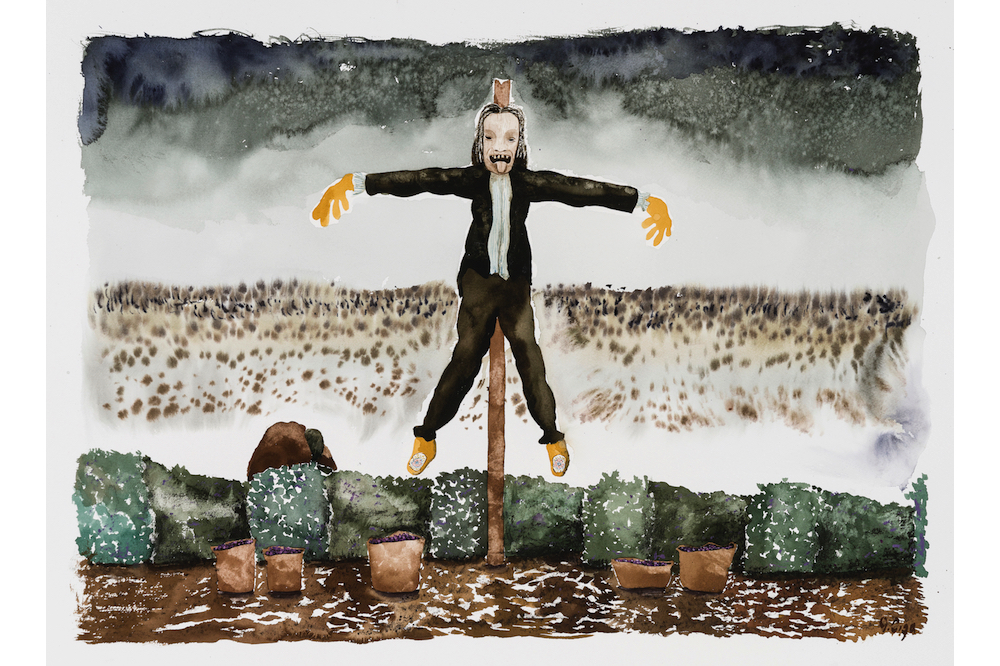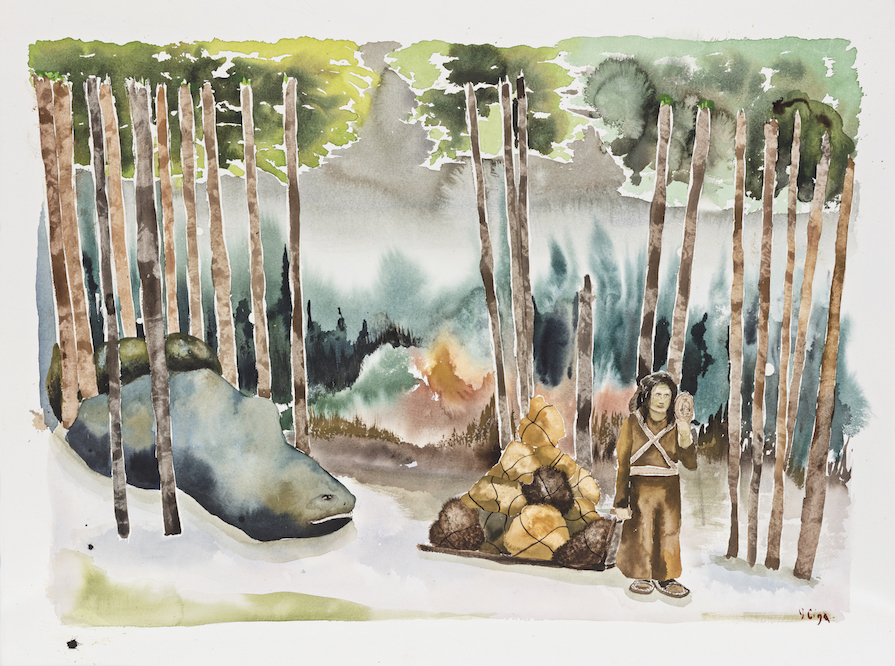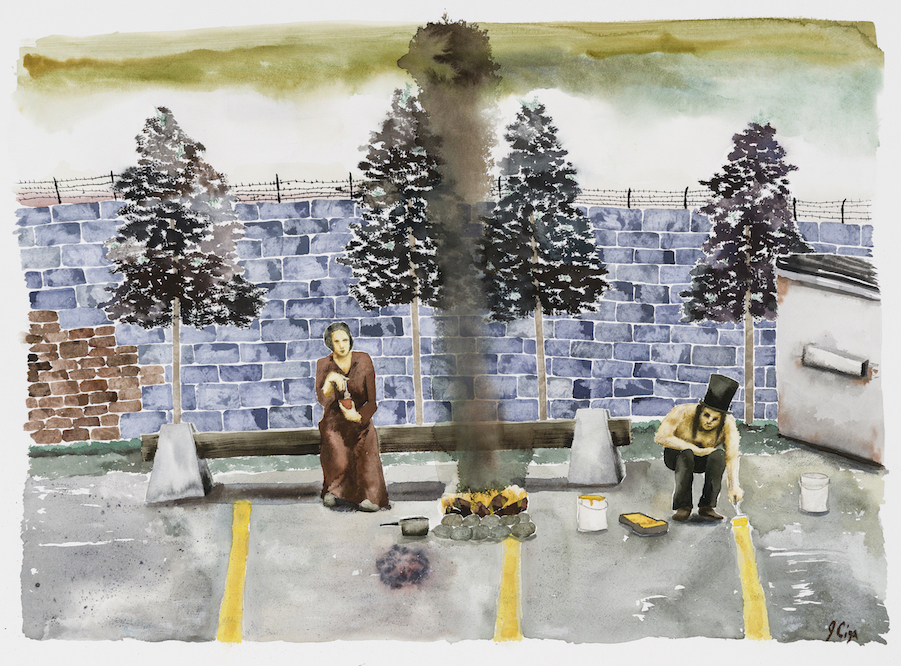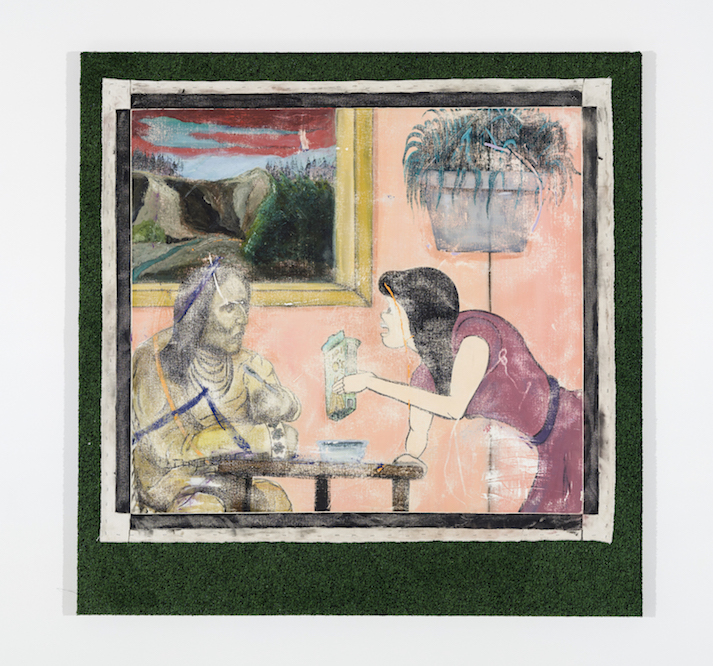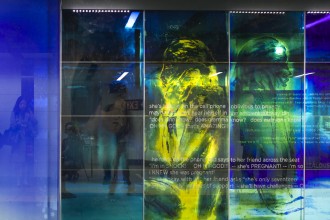Joseph Tisiga paints people in odd situations, and I keep wondering, how do they feel? The Yukon artist’s characters rarely show much emotion, even when they are being eaten by a giant worm, or interacting (in the nude, wearing a candelabra) with a door-to-door vacuum salesman – or just a guy hawking a vacuum cleaner, as the case may be – dressed head to toe in yellow and black stripes. The seventeen watercolors in Tisiga’s latest exhibition IBC: Dystopic Autonomy at Montreal’s Parisian Laundry (Oct 20-Nov 18) place Indigenous figures in a realm of normalized surreality, somewhere between Tisiga’s ambiguous mythological vision and our contemporary moment. Mostly they seem quietly stunned, the way people do when they’ve grown accustomed to fucked up circumstances.
Fittingly, the only character making a face is a scarecrow. Wearing moccasins and a stylized grimace that suggests a traditional mask, this “scary native” phantasm glares at viewers from his pole. It’s funny because many settler descendants really are unsettled by Indigenous people, but the Christ-type posture also suggests another critique of Western identity. Splayed out like Vitruvian Man, this scarecrow seems to mock the children of God who colonized Turtle Island. Tisiga, a member of the Kaska Dene Nation, has titled the work Trespassers Menaced by Psychosis (2017). Tisiga works more with mythology than allegory, but as paintings like this one indicate, he doesn’t mind signposting the way in. Meanwhile, in the background of the painting, a hunched figure gathers berries, confident of being left alone.
All the works in this show are like that: lucid on one plane, yet elusive on others. Tisiga’s paintings tell stories that are easy to follow but hard to catch, because they are chatty as well as coded, entertaining but also darkly contained. The works transmit much more than they say. The watercolors in IBC: Dystopic Autonomy echo the Kaska Dene legend of Dzohdié’, who killed a giant worm that had been terrorizing people. Because they twine around this mythic tale, we can follow the paintings along a narrative thread, like frames in a comic book or stills from a dreamlike movie.
As Maudie Dick, a Kaska storyteller born at the turn of the 19th century, told it in Our Voices: Native Stories of Alaska and the Yukon, the story begins when Dzohdié’ dreams of a bow and arrows and asks his grandmother to make them for him, which she does. At the same time, a mysterious giant worm starts terrorizing a young woman and her little child. The woman tries to assuage the worm’s hunger by giving it all their provisions, only to discover that the worm cannot be satisfied. Upset by this loss, her husband tries to recover what’s left of their food, but the worm eats him too. When she arrives at Dzohdié’s community and tells everyone what happened, they are so paralyzed by fear that they can hardly stand up. But at last, Dzohdié’ kills the worm by shooting it in the head with the bow and arrows his grandmother had made.
I don’t presume to interpret the tale any more than to paraphrase or summarize Tisiga’s telling of it, except to say that some of Tisiga’s paintings could be direct illustrations of this version of the story, while others are only obliquely connected. There are no text versions attached to the show, and if I hadn’t looked it up, I wouldn’t have been able to piece the narrative together. Even without the Google cheat, however, it’s clear that at the core of IBC: Dystopic Autonomy is the threat of a giant, hungry worm, and what to do about it.
Tisiga gives us a clue to the symbolism of the worm with three wall-sized black-and-white photographs of the inside of a factory. Apparently, they are images of a mining facility in the Yukon where the artist worked when he was younger. The mine forbade any photography, but the story from the gallery is that Tisiga came across these pictures several years ago, taken covertly by some former employee, and has been using them in his shows ever since. The photographs don’t name the lands that have been co-opted by the mine, nor the resources that have been extracted or the people that have profited from them. Neither do the images detail the processes that have been used or the lives of the people who’ve labored there. All we see is the inscrutable apparatus of the factory, bleakly intricate yet built for some basic purpose, toward which every dull metallic detail is inexorably bent.
In a dense and fascinating essay for Canadian Art this past spring, Tisiga offered further clues to the role of the worm in IBC: Dystopic Autonomy. He relates how his mother survived the Sixties Scoop and moved back to Whitehorse to reunite with their Kaska Dene family when he was eight. Having grown up “in the beige confluence of Western culture” and also worked for the last decade with vulnerable and marginalized people in the Yukon, Tisiga’s art practice now negotiates the raw edge of a “dystopic misalignment” between attitudes and social policies that strip away humanity and the humans forced to rely on that system because of its destructive effects. “The experience has instilled in my mind a deep sense of contemporary mythic conflict, one that pits the subdued realities of a complex human narrative against the ethereal spectre of … what?” Calling it a colonial structure isn’t enough, he writes, “but whatever it is, it’s distinctly alive and non-human.”
Rather than be an “ineffectual witness” to this dystopian drama, Tisiga discovered his artistic impetus in the desire to speak back to the miserable, self-propelling conditions he was vividly experiencing in his social work. By formulating a mythological context using the institutional cipher Indian Brand Corporation (IBC), Tisiga found he could “make work that hinges on the vague and corruptible histories that inform my identity, but are also oriented by the same supernatural ability that allows Dzohdié’ to kill a Giant Worm or Wile E. Coyote to paint a workable tunnel on a canyon wall.”
One of Tisiga’s worm-killing techniques is to refract – that is, flip and speak back – Western myths about Indigenous people, like the scarecrow in Trespassers Menaced by Psychosis, so we can more easily recognize them for what they are. Early colonial art offers a reference for Tisiga’s watercolors, such as that of Peter Rindisbacher, the Swiss watercolorists who emigrated to the Fort Douglas (now Winnipeg) as a teenager in the early 19th century. In the five years he lived there, Rindisbacher achieved international success with his paintings of settler encounters with Indigenous people in the region around the Red River. His watercolors were sold in England and Europe as advertisements, entertainments, and propaganda for colonial life on the so-called Western frontier.
Tisiga spoofs colonial painters’ alien fascination for Indigenous people and applies this parody to the ongoing rifts that white people would so eagerly reconcile. (Incidentally, Rindisbacher is still discussed as a documentarian.) Like Rindisbacher and many others, Tisiga presents us with stagey compositions of Indigenous people living their lives, but instead of campfires in teepees and hunters standing against beautiful landscapes, he’ll paint a couple minding a cooking fire in a parking lot beside a cinderblock wall topped with barbed wire (Quiet and Undesired Space, 2017), or dressed in hunting gear inside a cramped diorama (Cheapened by Scarcity, 2017). By applying the old filter of exoticism to these tender scenes from marginal life inside the big grey worm, Tisiga deflects Western conceptions of what these figures mean and how they should feel.
How did Dzodhie kill the giant worm? With arrows that he saw in a dream. Tisiga’s work confronts a “distinctly alive and non-human” force that’s out there in the world and that he can describe, but his fight seems primarily personal. The watercolors in IBC: Dystopic Autonomy appear to operate foremost within a private dreamscape, which overlaps and intersects with other mythologies and lived realities. But another series of five large oil paintings in the show, each titled A Prop for Reconciliation (2017), takes us to a more shared space.
Tisiga prefers duets – most of his paintings contain two characters – and in the case of the Reconciliation paintings, he’s paired off Archie characters with iconic Indigenous figures. Their interactions are cringe-inducing: Betty wraps an Indigenous woman in a Hudson’s Bay blanket; Jughead declines a pipe offering with an expression that says, “I don’t smoke”; Veronica thrusts a cereal box toward a man in traditional clothing; Archie bounces eagerly toward a sweat lodge with a towel draped over his shoulder; Dilton hesitatingly prepares to don a carved mask. The first three have their mouths open, unselfconsciously carrying on in an instructive tone; Archie is simply agape with excitement. Meanwhile, the Indigenous figures seem to be fading from the canvas.
The Reconciliation paintings are more forthright than Tisiga’s watercolors, and I spent most of my time at the IBC: Dystopic Autonomy show transfixed by them. But when I went back a second time, it was the watercolors I wanted to see again. Tisiga’s bold statements in oil are provocative and brilliant, but his mythic landscape dramas offer more to wonder upon. They invite intimate reflection, and for the giant worm, that is perhaps the more dangerous weapon.

